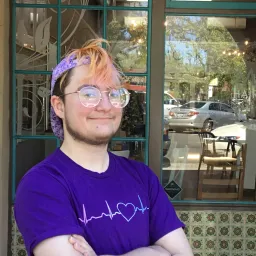Patrick Gem Gabbett
20 years old
He/Him/His & They/Them/Theirs
3 years in California's child welfare system.
Patrick entered care at the age of 17 after escaping his abusive family, with the support of his online friends, school staff, and journalism teacher. He has opted into extended care until this fall when he will age out of the system.
Patrick’s most consistent source of safety and support throughout his experience in foster care has been his friends, mostly starting off as online connections due to limited connection opportunities while living with his biological family. While his network has grown, online friends remain some of his closest companions. Patrick states “to be a good supportive adult or friend, you have to be compassionate and willing to check in and show you care. Just saying you’re there isn’t enough, especially for someone who’s going through abuse and struggling with mental illness--sometimes you have to be proactive and be the one to reach out first.”
Making the transition from living with his biological family to a foster home had its own set of challenges. Though not as blatantly abusive as his biological family had been, his foster home displayed a lack of education around trauma and mental health. His foster parents saw his online friendships as abnormal and pushed against him maintaining the connections, and saw any traumatic reaction or flashback as a personal attack against them. Mental health issues such as executive dysfunction and depression were seen as excuses, and Patrick’s bisexuality, while accepted, was a touchy topic.
He loved his foster family and wanted to be a part of it, but it seemed like they were incompatible, especially once his mental health issues became clearer and got worse with the lack of understanding, and his trauma didn’t “wear off” like the foster family expected it to. With the lack of awareness and acceptance, he was kicked out of his first placement when he turned 18, having to deal with yet another transition while still in high school. After leaving his first placement, Patrick lived in a SILP with a classmate’s family. It seemed fine at first, but the mother quickly turned violent, and he was forced to flee, spending the last half of his senior year of high school in a youth homeless shelter. He woke up at 5 a.m. every morning to take the train from Sacramento to Folsom, and managed to graduate with a 3.75 GPA with the support and help of his school, despite missing a substantial amount of time. After almost half a year of searching and several months after he graduated from high school, Patrick was able to escape homelessness and get his first apartment, where he has worked on creating a safe environment for him to thrive and heal in.
Currently, he is still living in his apartment, attending college and doing well in his classes. He is pursuing a journalism degree, focusing on social justice and advocacy in his writing, and his hope is to one day get a job in the journalism industry where he can uplift and support minority and marginalized voices. Before he entered care, Patrick came out as bisexual, but was still holding back his gender identity until he felt it was safe to come out as a nonbinary trans man. This was a long process for him--he was still struggling with his gender identity even when living in spaces that were trans-safe, and his ex-fiance, a lesbian, discouraged him from coming out as masculine. He is now a year and four months on testosterone, and living openly and happily as a trans individual.
Patrick would like to see a change in the training and vetting process provided to foster parents, specifically around the topics of mental health and LGBTQ+ to ensure that youth aren’t being placed in homophobic, transphobic, or ableist homes. He would also like caseworkers to receive training on ways to support LGBTQ+ youth, especially trans and nonbinary youth. He hopes that the caseworkers are able to create a safe space for youth where they are affirmed in their identity and know that what they are sharing is confidential and won’t be shared back to the home unless the youth chooses to.
Lastly, for young people who identify as LGBTQ+ within foster care, Patrick would like you to know that: “It's okay to remain in the closet if it ensures your safety and well being. Create a contingency plan if you are deciding to come out-- I hate that it has to be this way, but the child welfare system isn’t quite kind to us. But be proud of who you are, and don’t be afraid to explore yourself! Now here’s where I say you aren’t broken or wrong for being who you are, yada yada, things will get better, all that jazz. But honestly, what matters most is you. It’s probably gonna be hard, I won’t sugarcoat it, but you can make it out alive, and all the more fiercely queer for it!” As for the rest of the population: “LGBTQ youth exist! I knew when I was as young as four, and many others discover themselves at that age or older. Please center the voices of LGBTQ+ youth over the concerns of foster parents and others. We are the experts on our own lived experience, and our safety and access to vital medical care is more important than baseless moral quarrels and concerns that some potential foster parents might have with our existence.”

